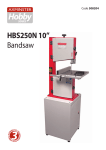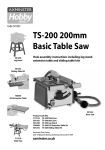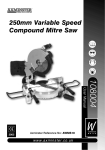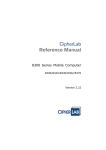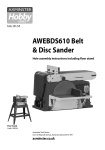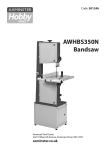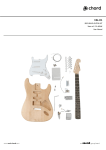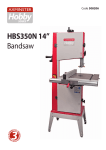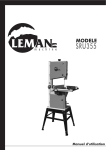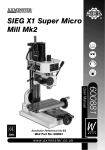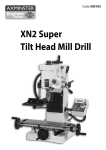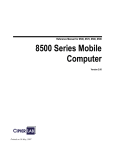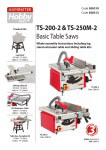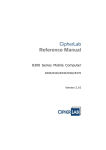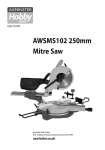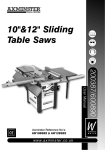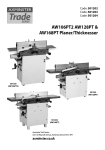Download Axminster AWEPT106 Operating instructions
Transcript
Code 501250 AWEPT106 260mm Planer Thicknesser Axminster Tool Centre, Unit 10 Weycroft Avenue, Axminster, Devon EX13 5PH axminster.co.uk Index of Contents Page No Index of Contents Declaration of Conformity What’s in the Box General Instructions for 230V Machines Specification Assembly Illustration and Parts Description Parts Breakdown Parts List Setting Up the Machine Operating Instructions (Overhand Planing) Operating Instructions (Thicknessing Changing the Planer Blades Running In and Periodic Maintenance Notes 02 02 03 04-05 06 07-08-09 10-11-12-13-14-15-23-24-25 16-17-18-19-20 21-22 26 27-28 29 30-31 32-33 34-35 Declaration of Conformity Copied from CE Certificate The undersigned, H.J. Kruge authorised by Qingdao Capital Resource Electric Co., Ltd. No. 155 Zhuzhou Road, Qingdao 266101, China declares that this product Model number PT260 Planer & Thicknesser manufactured by Qingdao Capital Resource Electric Co. is in compliance with the following standards or standardisation documents in accordance with Council Directives 2006/42/EC 2004/108/EC 2006/95/EC 2002/96/EC EN 61029-1:2009 prEN61029-2-3:2007 symbols below advise that you follow the correct Warning The safety procedures when using this machine. Fully read manual and safety instructions before use 02 Ear protection should be worn Eye protection should be worn Dust mask should be worn HAZARD Motor gets hot What’s in the Box Quantity 1 No. 1 No. 1 No. 1 No. 1 No. 1 No. 1 No. 1 No. 1 No. 1 No. 4 No. 1 No. 1 No. 1 No. 1 No. 1 No. 1 No. 1 No. Item Model Number Planer Thicknesser Model No. PT260 Outfeed Table Infeed Table Infeed Table Adjusting Screw Guide Fence and Bracket Packet containing Power Lead Dust Extraction Hood Chip Deflection Hood NVR Switch Assembly (Already wired complete) Packet containing M4 x 12mm Roundhead X-point Self Tapping screws and washers M10 Ring and Open-ended Spanner M13 Ring and Open-ended spanner 3mm Allen Key 6mm Allen Key Blade Setting Gauge Handle for the Rise and Fall crank of the thicknesser bed Instruction Manual 03 General instructions for 230V Machines Good Working Practices/ Safety The following suggestions will enable you to observe good working practices, keep yourself and fellow workers safe and maintain your tools and equipment in good working order. ! WARNING!! KEEP TOOLS AND EQUIPMENT OUT OF THE REACH OF YOUNG CHILDREN Mains Powered Tools Primary Precautions These tools are supplied with a moulded 13 Amp Plug and 3 core power cable. Before using the machine inspect the cable and the plug to make sure that neither are damaged. If any damage is visible have the tool inspected/repaired by a suitably qualified person. If it is necessary to replace the plug, it is preferable to use an ‘unbreakable’ type that will resist damage on site. Only use a 13 Amp plug, and make sure the cable clamp is tightened securely. Fuse at 13 amp. If extension leads are to be used, carry out the same safety checks on them, and ensure that they are correctly rated to safely supply the current that is required for your machine. This appliance must be earthed. Work Place/Environment Make sure when the machine is placed that it sits firmly on the floor, that it does not rock, that it is sufficiently clear of adjacent obstacles so that machining operations will not be impeded. Check you have adequate clearance both in front of and behind the machine when machining long stuff. If you are liable to be processing unwieldy or awkward work pieces, it is suggested that you consider fastening the machine down to the floor. The machine is not designed for sub-aqua operation, do not use when or where it is liable to get wet. If the machine is set up in the open, and it starts to rain (unusual though this would be in U.K.), cover it up or move it into the dry. If machine has got wet; dry it off as soon as possible, with a cloth or paper towel. Do not use 230Va.c. powered machines anywhere within a site area that is flooded or puddled, and do not trail extension cables across wet areas. Keep the machines clean; it will enable you to more easily see any damage that may have occurred. Clean the machine with a damp soapy cloth if needs be, do not use any solvents or cleaners as these may cause damage to any plastic parts or to the electrical components. (Keep the work area as uncluttered as is practical, this includes personnel as well as material). (Under no circumstances should CHILDREN be allowed in work areas). It is good practice to leave the machine unplugged until work is about to commence, also make sure to unplug the machine when it is not in use, or unattended. Always disconnect by pulling on the plug body and not the cable. Once you are ready to commence work, remove all tools used in the setting operations (if any) and place safely out of the way. Re-connect the machine. Carry out a final “tightness” check e.g. fence, blade guard, etc., check that the ‘machining path’ (the path that the work piece will travel) is unobstructed. (Make sure you are comfortable before you start work, balanced, not reaching etc). If the work you are carrying out is liable to generate flying grit, dust or chips, or the stuff is ‘spiky’ with lots of arris splinters, wear the appropriate safety clothing, goggles, gloves, masks etc. If the work operation appears to be excessively noisy, wear ear-defenders. 04 General instructions for 230V Machines If you wear your hair in a long style, wearing a cap, safety helmet, hairnet, even a sweatband, will minimise the possibility of your hair being caught up in the rotating parts of the machine, likewise,consideration should be given to the removal of rings and wristwatches, if these are liable to be a ‘snag’ hazard. Consideration should also be given to non-slip footwear, etc. Observe the old woodworkers adage of never allowing your hand/fingers within one handbreadth of the blades. DO NOT work with machine tools of any description if you are tired, your attention is wandering or you are being subjected to distraction. A deep cut, a lost fingertip or worse; is not worth it! DO NOT use this machine within the designated safety areas of flammable liquid stores or in areas where there may be volatile gases. There are very expensive, very specialised machines for working in these areas, THIS IS NOT ONE OF THEM. CHECK that blades are the correct type and size, are undamaged and are kept clean and sharp, this will maintain their operating performance and lessen the loading on the machine. Above all, OBSERVE…. make sure you know what is happening around you, and USE YOUR COMMON SENSE. 05 Specification Model Rating Power Feed Speed Cutterblock Speed Max Thicknesser Capacity Max Planing Width Max Depth of Cut Max Depth of Cut Thicknesser Max Depth of Cut Planer Knives Length of Table Min Extraction Airflow Required Dust Extraction Outlet Overall L x W x H Weight 06 AWEPT106 Hobby 2.2kW 3.5m/min 6,500 rpm 160mm 260mm 3mm 2mm 3mm HSS(Disposable) x 2 1,040mm 1,000 m³/hr 100mm 1,120 x 780 x 950mm 70kg Assembly Having unpacked your planer/thicknesser (see below) and its accessories, please dispose of any unwanted packaging properly. The cardboard packaging is biodegradable. Please unpack your new machine and check that all the components against the “What’s in the Box” list. Care should be taken when removing the main assembly of the planer thicknesser from the box, (a) it is heavy and (b) the motor control and junction boxes actually protrude below the level of the cabinet enclosure; they are only plastic….caution. Likewise the ON/OFF NVR switch assembly are ‘hanging loose’, make sure you do not trap and damage the cables whilst manoeuvring the machine. Step 2 C Pre-drilled holes NVR Switch, Assembly You will require the two supplied M4 x 50mm Phillips Screws (A) and a screwdriver. Step 3 Line up the two fixing holes in the NVR switch assembly (B) with the pre-drilled holes in the guard (C) (See steps 1-2) (NOTE Make sure the socket is pointing downwards, see step 3). Introduce a M4 x 50mm Phillips screw (A) into the top hole (b), in the NVR switch assembly and lightly screw it into the guard (C) (See step 4). Repeat for the remaining fixing hole, see step 5 then tighten both screws. (DO NOT OVER TIGHTEN) Socket Step 4 Step 1 A b B Fixing hole Continues Over.... 07 Assembly Step 5 Tighten the two M4 screws (DO NOT OVER TIGHTEN) Step 6 The NVR switch assembled Fitting the Infeed Table Identify the two capping strips on the infeed side of the machine (see fig 2). These capping strips, and the machined rebates in the castings of the main chassis form the ‘slides’ for the infeed table. Loosen the caphead bolts that secure them, and lift clear. Note. These strips are precisely located with roll pin dowels and you may need to gently prise them off with a flat blade screwdriver? Set them carefully aside, they and the rebates have had a heavy application of silicone grease. Do not remove the grease, and do not let the grease pick up any contaminants, especially anything gritty. 08 Identify the infeed table. It has the guide fence mounting bolted on one side (see fig 5) and on the opposite side there is an engraved line which will be the infeed setting reference mark (see fig 9). Identify the infeed table adjusting screw. Remove the collar by undoing the hex socket grubscrew, remove the plate and spring washers. Thread the adjusting screw through the housing in the end of the table, refit the spring washer, the plate washer and the collar (see fig 4). Tighten the collar onto the adjusting screw shaft, ensuring the grubscrew is driven into the drilled pocket in the shaft. Move this assembly to the infeed side of the machine and locate the threaded hole in the cross bar, (see fig 1) introduce the thread of the adjusting screw, commence screwing home. (This is a long and laborious job, I suggest you leave the capping strips off until you have completed screwing home the adjusting screw, as this will enable you to GENTLY rock the table up and down and establish the correct alignment of the shaft and the threaded hole). As you approach the correct position for the table, you will notice the infeed setting scale approaching register. Stop when the reference mark is about half scale, with the table lugs sitting flat on the machined rebates. Refit the capping strips, position the locating dowels carefully, press home. Refit the caphead bolts and finger tighten. Tap, knock, rock, whatever, the infeed table from side to side to centralise it between the capping strips. Tighten the caphead bolts down securely. This should make the infeed table impossible to move. Now slacken off the capping strip securing bolts by a twelfth of a turn (half a flat of the caphead). Assembly Fitting the Infeed Table The table should now be able to move, if it doesn’t, slacken a shade more. (Please note that the adjusting movement is quite stiff, as the table lugs are captured with only a small clearance to allow movement, but maintain rigidity when the machine is used in the overhand mode. Keep the capping strip securing bolts as tight as is practically possible, whilst allowing the table to move). Check the table moves up and down, at least between the extreme marks on the setting scale, (remember you will have to take up the ‘slack’ when you reverse direction of the table movement). Fitting the Chip Deflection Cover Identify the chip deflection cover and the 4 No. self-tapping screws and washers. Move to the outfeed side of the machine and locate the aluminium extrusion mounted on the cross bar in front of the anti-kick back fingers (See fig 5). Position the cover in the channel in the extrusion and secure by screwing the self-tapping screws (with their washers), through the pre-formed holes in the cover into the slot in the extrusion. The complete assembly should be able to pivot around the cross bar, up and over the cutter block, or return into the void above the edge of the thicknessing table (see fig 6). Fitting the Handle to the Rise and Fall Crank of the Thicknesser Bed Locate the handle, screw the projecting thread into the tapped hole in the crank arm as far as the lock nut, tighten the lock nut down securely against the crank arm. Fitting the Outfeed table Open the Outfeed table clamps, (see fig 5). Raise the upper guard out of the way. Pivot the chip deflector cover to the down position. Place the lugs of the outfeed table into the machined rebates on the outfeed side of the machine. At the lower end of the mounting lugs are two location brackets. The lower open slot in these location brackets fits over the peg dowels screwed into the chassis (see fig 5). At the top end of the nearside lug is a small bracket (see fig 7) that depresses a sprung stop that then allows the nearside clamping lever to be turned to the clamped position. This in turn moves a sprung bobbin which orientates a microswitch interlock to indicate the machine is in ‘Planer Mode’. Press down firmly on the table, having ensured all the locators are positioned correctly, turn the clamping levers to lock the table down. The guide fence components come fully assembled, but not tightened. Unscrew the bolt to enable it to be slid into the slot in the mounting, position where required and tighten the lever handle. The fence is bolted to the support bracket by two coach bolts, washers and nuts. The coach bolts fit into a ‘T’ slot moulded in the fence (see fig 15). Adjust the ‘fore and aft’ position of the fence to the position required and secure by tightening the nuts, make sure the “notch” on the underside of the fence straddles the cutter block (see fig 8). Fitting the Guide Fence The angle of the fence can be set between the preset 0 degree and 90 degree positions by loosening the lever handle, adjusting to the angle required and re-tightening. There is a scale embossed on the support bracket casting to give a guide to the angle you are setting (see fig 14). The lever handles are the ‘lift’ to disengage type. e.g. if the lever is turned into a position where it is fouling against the guide fence mounting bracket, pulling the handle up on its shaft, against its spring keeper, will disengage the spline drive and can be moved freely away from the obstruction. Allowing the handle to be sprung back will re-engage the spline and the handle will again act as a lever. 09 Illustration and Parts Description Infeed table adjusting screw Capping strip Cross bar Fig 1 Fig 2 Shaped cut out in dust extraction hood Fig 3 10 Motor mounting plate securing nuts Upper guard assembly raise and lower lever Illustration and Parts Description Fig 4 Infeed table adjusting handle Infeed table adjusting screw Rise & fall handle for thicknesser bed Fig 5 Guide fence mounting bracket Anti-kick back fingers Outfeed table clamps Upper guard slide lock Peg dowel Anti-kickback fingers Peg dowel Aluminium extrusion Outfeed table clamps 11 Illustration and Parts Description Dust extractor Infeed table adjusting handle Fig 6 Chip deflector Upper guard assembly Typ. threaded corner spindle Thicknessing depth scale and pointer Adjusting grub screw Fig 7 Actuating bracket Microswitch Sprung stop Sprung bobbin 12 Illustration and Parts Description Upper guard assembly Thicknessing bed rise and fall handle Guide fence Upper guard rise and lower lever Outfeed table Infeed table adjusting knob handle Infeed table Dust extractor Chip deflector (closed position) Thicknessing bed Main chassis assemby NVR On/Off switch assembly Drive belt cover Cabinet stand assembly Fig 8 13 Illustration and Parts Description Stand assembly A preformed metal stand that encloses the motor. The main chassis (See Fig 8) assembly is bolted to it. The whole is then bolted to the cabinet stand. Main chassis assembly (See Fig 9) The main body of the machine that all the other parts are mounted upon. Infeed table adjusting screw (Unseen) The infeed table adjusting screw is held captive in a ring casting on the front underside of the infeed table. It is a long length of rod with a handle moulded on one end and a thread cut on the other. The threaded part of the rod engages in a tapped hole in a cross bar of the main chassis. Because the adjusting screw is held captive in the infeed table, screwing the rod backwards and forwards will move the infeed table backwards and forward on its slideways on the main chassis. Infeed table (See Fig 8) The table that supports the material on the input side of the machine. It moves up and down in a pair of inclined slideways machined in main chassis, the level of the table is set relative to the top of the planer irons; this setting governs the depth of cut that can be taken during the overhand planing operation. The guide fence mounting bracket is attached to the infeed table. Thicknessing bed This handle is fitted to a crank arm formed on one of the threaded rise and fall spindles that carry the thicknessing bed. There are four threaded handle spindles that are connected by a chain drive in the lower part of the (See Fig 9) main chassis assembly. The chain drive is tensioned by an idler gear, which should be checked periodically. 14 Outfeed or take off table (See Fig 9) The table that supports the work after it has passed over the cutter block during the overhand planing operation. The level of the table is set to be in line with the top of the plane irons, thus once the cutting action is finished the table will support the workpiece during the remainder of the planing pass. The outfeed table is removed for thicknessing operations, to allow better access to the material passing over the thicknessing bed. Upper cutter block guard assembly (See Fig 9) An aluminium extrusion covers the cutter block. It can be positioned both in height and laterally. It is mounted in a housing at the top of the support leg. The support leg has a rack machined into it which engages with a pinion moulding which has a lever extrusion. Moving the lever up and down will drive the support leg up and down, thus varying the height of the upper guard. The guard mounting housing has a clamp set in it which enables the guard to be clamped laterally. Outfeed table clamps (See Fig 9) These are the two clamps set on each side of the main chassis that clamp the outfeed table in position during the overhand planing operation. The offside clamp position is also critical, in that it is part of the interlock sequence, care must be taken to ensure the correct configuration is met whilst setting the machine up for planing or thicknessing. See the Operating Instructions. Drive belt cover (See Fig 8) A moulded cover mounted on near side of the main chassis, secured by a domehead nut. Illustration and Parts Description Thicknessing bed rise and fall handle Outfeed table Upper cutter block guard assembly Guide fence Infeed scale and index mark Capping Strip Infeed table Outfeed table clamp Stand assembly Fig 9 Main chassis assembly 15 Parts Breakdown Fig 10 16 Parts Breakdown 17 Parts Breakdown Fig 11 18 Breakdown 19 Breakdown Fig 12 Cabinet 20 Parts List (Part 1) 21 Parts List (Part 2) 22 Illustration and Parts Description Thicknesser feed A moulded cover mounted on the off side of the main chassis, secured drive cover by two domehead nuts. (See Fig 13) Dust extraction hood (See Fig 13) A moulded plastic hood with a 100mm dust extraction port. When fitted in the void over the thicknessing table during the planing operation, it acts as a guard to the underside of the cutter block, the initiator of part of the interlock circuit, as well as collecting the chips and shavings. Chip deflection hood (See Fig 13) A moulded plastic hood fitted into an aluminium extrusion that is pivoted on a cross bar in the main chassis assembly. During overhand planing operations it is folded into the void above the thicknessing bed beneath the outfeed table. During thicknessing operations, it is folded up and over the cutter block to act as the upper guard; it also sets part of the interlock circuit as well as deflecting the chips and shavings away from the machine. It is moulded in such a way as to allow the dust extraction hood to clip over it and form the dust extraction pathway for connection to your dust extraction system. Anti-kickback fingers (See Fig 5) A series of shaped metal fingers mounted on a cross bar in the main chassis assembly, at the entrance to the thicknesser void. They are shaped and pivoted such as to allow the entrance of the material onto the thicknesser bed, but will not allow it to be withdrawn, or ‘kicked back’ when it comes into contact with the cutter block. To overcome the anti-kickback fingers, you have to lower the thicknesser bed to a degree whereby the material could not be fed into the cutter block. NVR Switch assembly The NVR Start/Stop buttons are beneath the“quick” action stop shroud. Standard marking with ‘I’ indicating Start and ‘O’ indicating Stop. Guide fence (See Fig 9) The guide fence is an aluminium extrusion and angled support bracket. The whole assembly is bolted to the guide fence mounting bracket on the side of the infeed table. The support bracket also mounts the ‘dead space’ guard plate (the guard that covers that portion of the cutter block behind the guide fence). 23 Illustration and Parts Description Typ. outfeed table clamp Thicknesser bed rise & fall crank Chip deflection hood Guide fence assembly Infeed table adjusting knob Dead space plate Dust extraction hood Thicknesser feed drive cover Fig 13 24 Illustration and Parts Description Tilt scale & pointer Fig 14 Tilting action clamp Infeed table adjusting handle Clamping bolt Tilting action clamp Fig 15 Preset 45˚ stop Typ. fore & aft adjustment of guide clamp bolt 90˚ Preset 25 Setting Up the Machine NOTE. The top edge of the planer blade should be in line with the top of the outfeed table, and the infeed table when the infeed table is registered at zero cut. The machine is ‘factory’ set, but if you have any doubts, or if, in the course of usage the machine sustains a ‘knock’ et al., and you wish to check the basic parameters, proceed as follows:Checking tables in plane Adjust the infeed table to its highest limit against the register marks, fit the outfeed table. Put an engineers’ straight edge (preferably 1000mm) along the tables and check that the edge is in contact all along both tables, if it is not set the outfeed table to the infeed table. Adjust the edge of the infeed table to the same height as the edge of the outfeed table (across the cutter block). At the bottom of the locating lugs of the outfeed table are two grub screws that will enable the outfeed table to be ‘tilted’ (see fig 7). Loosen the outfeed table clamps, adjust the grub screws, tighten the clamps, check the level. Proceed in this manner until the tables are in plane. If the tables are ‘in twist’, make or use two ‘winding’ sticks, (two ‘sticks’ that have the same dimensions) stand one on each table near the ends (across the table) sight across the two edges and see if they are parallel, or the tables are ‘in wind’ to each other. (Note. The longer the sticks the greater the amplification of the fault). Proceed as with getting the tables in plane, only this time adjust the grubscrew at the relevant side of the table. Setting the Guide Fence Lock the guide fence in position on the table and upright. Check the heel of the casting is hard up against the preset stop (see fig 15). Place an engineers’ square on the table and move against the fence. If the fence is out of upright, loosen the fence, adjust the stop, put the fence back to upright, tighten and check again. Proceed in this manner until the fence is set correctly. Check that the pointer is reading zero against the embossed scale, if not, check that the guide fence mounting is correctly clamped to its mounting bracket. If it is, make a note or mark to read the discrepancy between the pointer and the scale during future settings. Loosen the fence and tilt to 45 degrees, check that the toe of the casting is hard against the preset stop (see fig 15). Measure the angle of the fence with a bevel gauge or engineers’ combination square and check it is 45 degrees, if not, adjust the preset stop until the correct angle is achieved. Check the pointer is reading correctly against the scale. 26 Operating Instructions (Overhand Planing) Note. There is an electronic braking system on your machine, which works by switching the ‘run’ capacitor. When you stop the machine after it has been running, you will hear a “click, click” sound as the brake activates, and the motor will slow down quite quickly. Please be aware that the effectiveness of the braking action is dependent on the ‘run’ capacitor being fully charged; this takes a finite time after the motor has been started. If you start and then stop the machine very quickly, without allowing sufficient time for the ‘run’ capacitor to charge fully, the switching occurs (i.e. you will hear the clicking sound) but there is no apparent braking action. Additional Note. To carry out the overhand planing operation; the interlocks are set such that you require the dust extraction hood and the outfeed table fitted correctly. 1.Make sure you have read and fully understood the General Instructions and safety precautions that are printed in the preceding pages of this manual. 2.Before connecting the machine to the supply; check for obvious signs of damage, paying particular attention to the plug and the power cable. Rectify or have rectified any damage you discover. Check the blades are not damaged; that they are clean and sharp. Change the blades if necessary. 3. Set the thicknessing table to approximately 100mm and insert the dust extraction hood. Raise the bed so that the hood is held in place and correctly operates the safety microswitch as shown in figs 1 & 2. Connect up your dust extraction system (if available). 4. Set the fence, leaving sufficient exposed width of planer blades for you to machine the largest dimension of the workpiece. 5. Check that all accessories, tools etc., which have been used to set the machine up, are removed and set carefully aside or stowed away correctly. 6. Lower the infeed table to give the required cut, (e.g. maximum to work badly distorted or very roughly finished timber, minimum to ‘finish’ a fine straight cut off a saw?). Put the workpiece onto the infeed table and advance to the cutter block, set the upper guard to ‘just’ clear the workpiece, covering the whole of the exposed part of the cutter block. 7. Check the workpiece. Select the ‘face’. (The first planing operation). Ensure that, if possible, you are not planing against the grain, and that if the stuff is bent, that the back of the bow is uppermost. 8. Check (especially on site), that there are no foreign objects e.g. old nails, screws, small stones etc. embedded in the material you are about to cut. 9. Plug the power cable into a correctly rated switched socket outlet. If extension leads are being used, check these for damage, do not use if damaged; if you are working outside, check that any extension cables in use are rated for outside work 10. Press the start button, allow the machine to run up to speed. Put the workpiece onto the infeed table and advance over the cutter block, maintain a constant downward pressure on the stuff whilst feeding, and ‘skip’ your hands over the upper guard when you reach it. Make as many passes as required to render the stuff flat and straight, let the machine run to a stop. Put the stuff aside, and if dust extraction has not been available, clear away any chips/shavings that have built up, particularly in the dust extraction hood. Continues Over.... 27 Operating Instructions (Overhand Planing) 11. Select an ‘edge’. (The second planing operation). Ensure that, if possible, you are not planing against the grain, and that if the stuff is bent, that the back of the bow is uppermost. 12. If necessary, alter the infeed table setting as required for planing the edge. 13. Set the fence, leaving sufficient exposed width of planer blades for you to machine the edge dimension of the workpiece. Check the fence is ‘right’ (i.e. At right angles to the table). 14. Lower the upper guard to cover the planer blades and leave a gap approximately the size of the material between the fence and the edge of the guard. Lower the workpiece onto the tables, push up against the fence and adjust the upper guard so that its edge is just ‘sprung’ against the timber. Remove the timber. 15. Press the start button, allow the machine to run up to speed. Put the workpiece onto the infeed table and advance over the cutter block, maintain constant downward pressure and side pressure against the fence whilst feeding. The upper guard should be ‘nudged’ out of the way as you advance the wood over the cutter block and provide a little side pressure to help the operation. Make as many passes as required to render the wood flat, straight and right. Press the stop button and let the machine run to a stop. 16. Mark the ‘face’ and the ‘face edge’ for later reference. Put the timber aside, set the machine for thicknessing. 28 Operating Instructions (Thicknessing) Additional Note. To carry out the thicknessing operation; the interlocks are set such that you require the dust extraction hood removed from the thicknessing table void and the outfeed table removed, (which allows the chip deflecting hood to be swung up and over the table to act as the cutter block guard as well as the chip deflector). 1. Make sure you have read and fully understood the General Instructions and safety precautions that are printed in the preceding pages of this manual. 2. Before connecting the machine to the supply; check for obvious signs of damage, paying particular attention to the plug and the power cable. Rectify or have rectified any damage you discover. 3. Check the blades are not damaged; that they are clean and sharp. Change the blades if necessary. 4. Raise the blade guard to its maximum height. Undo the two side clamps and remove the outfeed table. Lower the thicknesser bed and swing the chip deflection hood up and over the table. 5. Remove the dust extraction pan and, if you are using dust extraction, fit to the deflection hood (see fig 6). 6. Hold it in place by lowering the Upper blade guard onto it. Connect up your dust extraction. 7. Measure the size of the wood you want to thickness. Set the thicknesser bed to this dimension against the depth scale on the side of the machine (see fig 6). 8. Press the start button and allow the cutter block to run up to full speed. 9. Take up the wood and orientate the material so that the ‘marked’ face or edge of the pre-measured dimension is down, i.e. will be in contact with the thicknessing bed, and you are not cutting against the grain. Push the material firmly into the machine until the feed roller ‘picks up’ the material and moves it through the machine. Move around to the ‘back’ of the machine and take hold of the stuff to prevent it falling to the floor when the machining pass is complete. Measure the dimension you have just cut and calculate how much more material you have to remove to reach the required size. Raise the thicknessing bed for the new cut. NOTE. One complete turn of the crank handle raises (or lowers) the bed 3mm. Repeat the process. REMEMBER you will want to ‘clean up’ your marked surface as well (to remove possible imperfections, e.g. planing ripples, small ‘dips’ that didn’t clean perfectly during the overhand phase, etc). 10. Continue until you have achieved the correct size, and then reset the bed to machine the other dimension. Proceed as in 6. above. 29 Changing the Planer Blades ! DISCONNECT THE PLANER FROM THE MAINS SUPPLY Planer blade fixing system The cutter block has two plane iron slots machined into it to take the planer blades and their securing components. The trailing edge of each slot is set at the precise angle required by the blade to plane the material efficiently. It therefore follows that the securing method will look to lock the blade hard against the trailing edge of the plane iron slot, with the correct protrusion to effect a cutting action. The blades are clamped into the slot by the chip breaker cum lock bar which has four bolts fitted into threaded holes in its reverse face, these bolts are ‘unscrewed’ so that the heads push against the opposite side of the plane iron slot, (the leading edge), thereby pinching the lock bar and the blade in the slot. On the face of the chip breaker are two miniature dowels, which locate the blade in place relative to the chip breaker. The face of the chip breaker is angled to match the angle of the trailing edge of the slot. With the ‘pinching’ bolts extended even half way, the blade, chip breaker and the bolts form a wedge that cannot be removed from the plane iron slot. The long edge of the chip breakers have three holes drilled and tapped through, which have grubscrews to help with the setting of the planer blades. Changing the Blades Very carefully roll the cutter block with your fingers (at the end?) until the plane iron slot is accessible. Using the 10mm spanner supplied with your toolkit, loosen the 4 hexhead bolts that are clamping the chip breaker/lock bar and the blade in the slot. Screw the bolts home until you are able to lift the complete assembly out of the plane iron slot. Remove the blade and set aside. Chip Breaker lock bar Blade setting gauge Noise reduction slots Fig 16 30 Cutter block Blade Securing bolt Changing the Planer Blades Changing the Blades Clean the chip breaker of any accumulated resin etc., and clean the plane iron slot thoroughly. If the blade has only been used on the one edge, clean, remove any accumulated resin etc, and refit to the chip breaker with the new edge up. Alternatively fit a new blade. Drop the complete assembly into the plane iron slot and unscrew the bolts until the blade is lightly pinched. Screw each bolt in one flat (of the hexhead bolt). Set the blade setting gauge on the cutter block (see fig 16) (within the noise reduction slotting on the table edges) with the cut-out over the blade; there should be three areas of contact:- a) the right side of the gauge on the block, b) the edge of the blade, and c) the left side of the gauge on the block. If the edge of the blade is touching and both sides of the gauge are high, then the blade is too high; if both sides of the gauge are touching and the edge of the blade is not, then the blade is too low. If the blade is too high, unscrew the grubscrews in the chip breaker which will allow the chip breaker to drop down taking the blade with it. Vice versa if the blade is too low. Measure the blade height at each end of the blade and in the middle, adjusting the grub screws as necessary. (Tip: Screw the middle grubscrew out of the way and adjust using the two end ones. When the blade is set and pinched in; screw the centre grubscrew down). Continue until the measurements are correct right across the blade. Tighten the bolts securely. NOW check again, if the measurements are correct proceed to the changing of the other blade, if not, loosen the bolts and re-adjust. Continue in this way until you have achieved the correct measurements and the blades are pinched in tight. When everything is complete collect any tools, setting gauge etc, place carefully away. Turn the cutter block at least 2 revolutions by hand, if there are no bumps, grating noises, knocks or bangs, assume everything is correct, reconnect the machine to the mains supply outlet. Switch on for a brief burst. If everything is again O.K., the machine is ready for use. If necessary check the machine parameters as detailed in setting up the machine. 31 Running In and Periodic Maintenance After the initial 5-10 hours of operation, remove the Drive belt cover and check the belt tension. A steady push of some 5lb force should produce a deflection of between 1/2”- 3/4”(1220mm) (see fig A). At least once a week, clean either with brush or compressed air, all the debris, dust, etc., etc., on the 4 threaded corner spindles (see fig C) of the thicknessing bed rise and fall mechanism. When they are clean, lubricate with a spray oil (WD40, Duck Oil?). Lubricate the chain drive with a light machine oil, and wind it through several cycles. Remove any excess oil carefully. Thereafter check every 100 hrs of running. Clean out the space usually enclosed by the cover. Replace the cover, refit the domehead nut, tighten securely. Remove the thicknessing drive cover, clean the gears and the chain enclosure with a brush or blow clean with compressed air. Lubricate all bearing points with a few drops of light machine oil. (3 in 1?)(see fig B) Do not contaminate the flat drive belt with oil. Replace cover, refit the two domehead nuts, tighten securely. As regularly as required, clean the overhand tables and the thicknessing bed of any accumulation of resin. A proprietary cleaning agent such as Woodglyde is recommended. This will break down the resin build up, lubricate the surfaces and slow down the build up of the next resin accumulation. Fig A 32 Running In and Periodic Maintenance Fig B Oil Oil Oil Oil Oil Oil chain drive Oil Oil Oil Threaded corner spindle Fig C 33 Notes 34 Notes 35 Please dispose of packaging for the product in a responsible manner. It is suitable for recycling. Help to protect the environment, take the packaging to the local recycling centre and place into the appropriate recycling bin. Only for EU countries Do not dispose of electric tools together with household waste material. In observance of European Directive 2002/96/EC on waste electrical and electronic equipment and its implementation in accordance with national law, electric tools that have reached the end of their life must be collected separately and returned to an environmentally compatible recycling facility.




































